Accelerating wages growth has Morgan Stanley tipping more interest rate hikes
The fight against inflation involves deploying the policy levers to shift the economy into a different mode. One of those policy levers is wages. And while that lever can be pressed by governments, corporates too have their role to play.
A new note from Chris Nicol, Chris Read and Antony Conte from Morgan Stanley highlights the issue:
"Aggregate wage growth remains relatively contained, although this is driven largely by inertia in wage settings, and costs look much more pronounced after adjusting for historically poor productivity.
This is likely to result in further acceleration over 2H23, keeping services inflation elevated and corporate margins under pressure. We expect this will contribute to a relatively more hawkish RBA stance. We also update our screen of ASX100 labour cost exposures," they said.
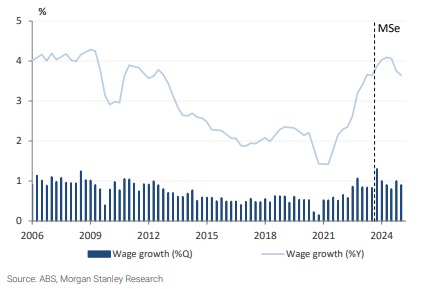
While Australia's wages growth has been relatively contained at 3.6% y/y, the analysts expect it to accelerate. Nicol, Read and Conte explain how Australia's wage-setting system is directly responsible for this situation. With around 25% of workers are on awards and their wages are set by the Fair Work Commission once a year, and a further 40% are on enterprise bargain agreements which typically lock in pay rises for three years, they conclude
"This creates much more inertia in Australia's wage growth and, as a result, means we expect to see a continued acceleration in wages over 2H23, in contrast to almost every other DM economy."
The award wage increases of 5.75% effective July 1, which comes after a 4.6% increase last year will result in a lift in wages in Q3, as it did last year. As the chart below indicates, these two years are significantly higher than the award wage increases since 2011.
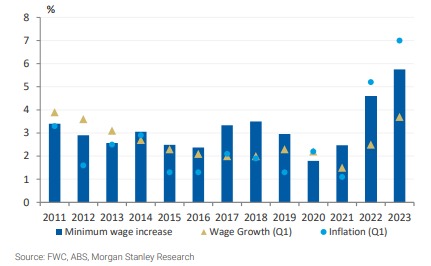
While the average wage rate for new EBAs signed over the first half of this year was relatively steady at around 3.5% annual average over the life of the agreement, the rate has increased sharply over the last two months to the extent that average wage increases sitting at 4.6%.
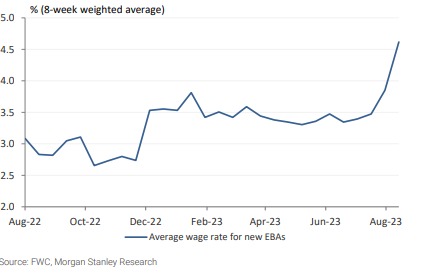
Private sector wage increases are outpacing those of the public sector, with a significant gap emerging over the period 2022-2023:
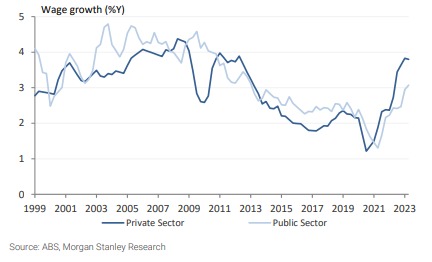
Labour market conditions loosening
As a lag indicator, the near-term trajectory of wage growth must be viewed from the broader context of labour market conditions. The analysts interpret other indicators as consistent with a gradual loosening in the tightness of labour markets, but caution this has slowed over the past few months.
"As a result, labour underutilisation (unemployment and underemployment) has been rising gradually over the course of the year [Exhibit 6] but remains well below pre-COVID levels and the range of estimates for full employment [Exhibit 7]," they said.
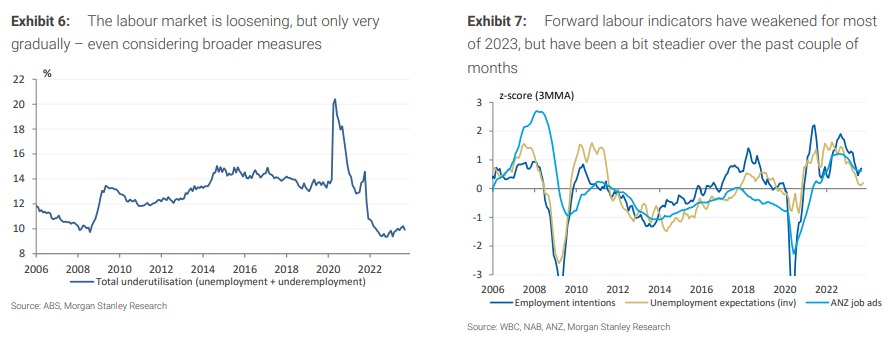
Source: Morgan Stanley, October 2023.
For NIcol, Read and Conte, the data suggests less upward pressure from this point onwards for more flexibly set wage growth, with a likely peak for overall wages early next year, combined with limited downward pressure over the next 12 months.
Productivity weakness amplifying labour costs and inflation
That labour market conditions have held up much stronger than the broader economy has implications for productivity (GDP per hour worked), which has fallen at a historic pace, back to 2016 levels, as seen below in Exhibit 8.
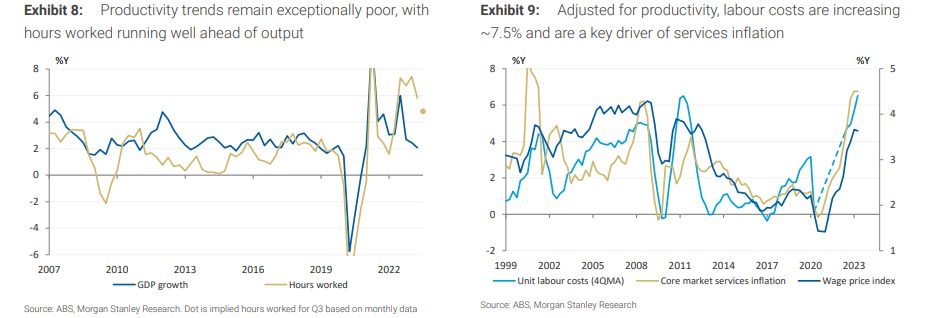
Source: Morgan Stanley, October 2023.
Exhibit 9 above also demonstrates how lower productivity impacts the outlook for inflation. Nicol, Read and Conte explain this link:
"While wages growth is well contained (3.6%), once adjusted for productivity (i.e., unit labour costs), it rises to ~7.5%, which is above many other comparable economies. This is a key reason why inflation categories more exposed to labour (i.e., services inflation) remain persistently high," they said.
While they note how monthly data for July-September suggest some improvement in productivity trends, the fact that hours worked fell 0.5% QoQ doesn't mean a comparable decline in GDP. They also anticipate that the improvements in productivity trends will be offset by the acceleration in wages, meaning services inflation pressure will remain elevated.
Key focus for the RBA
The next interest rate decision from the RBA is due on Melbourne Cup Day, 7 November 2023. The analysts expect the RBA will remain hawkish on interest rates. While they observe that wage growth is an important part of the RBA's decision-making framework, they believe the "upside to the near-term wage outlook and continued tight labour market conditions are among the reasons we see further monetary tightening as likely and have a rate hike forecast for the November meeting."
What will it take for the RBA to shift its stance and look to rate cuts? Nicol, Read and Conte conclude
"A softer labour market remains the key requirement for the RBA to move more confidently on old and look toward eventual rate cuts – it would provide confidence in a peak in wages growth and also likely improve cyclical productivity trends, both of which would drive services disinflation," they said.
Margin risk for companies
Wage growth also impacts corporates, where it creates a key margin risk, especially for companies with more persistent labour cost backdrops (from EBAs for example) and cyclical top-line exposure. One way they measure this is to track the mentions of labour costs in their recent announcements. As Exhibit 10 below indicates, the mention of labour costs is trending upwards.
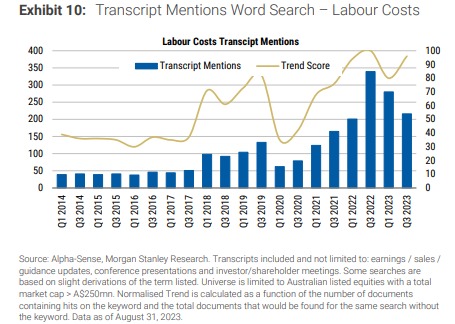
A breakdown by sector of labour cost mentions indicates the discretionary, financial, industrial, real estate and health care sectors had the highest rates of mentions.
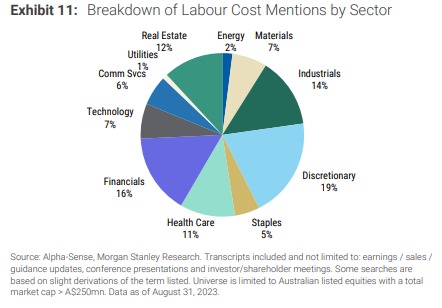
The analysts have updated their ASX100 Labour Cost Screen for FY23 results, highlighting those companies with the highest labour costs exposures as a share of sales.
The ten companies with the highest labour costs as a percentage of sales are Ramsay Healthcare (ASX: RHC), Flight Centre (ASX: FLT), Worley (ASX: WOR), Wisetech Global (ASX: WTC), Steadfast Group (ASX: SDF), Sonic Healthcare (ASX: SHL), Computershare (ASX: CPU), Altium (ASX: ALU), Seek (ASX: SEK) and Cochlear (ASX: COH).